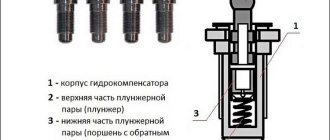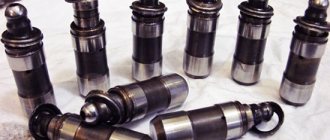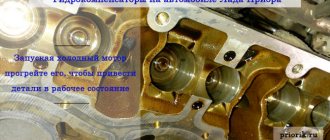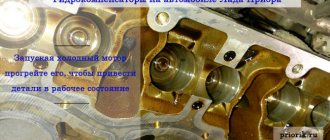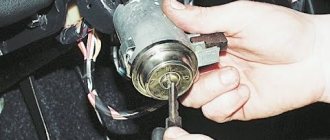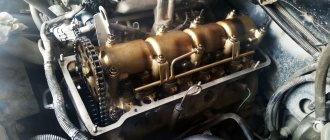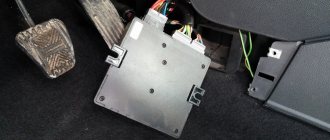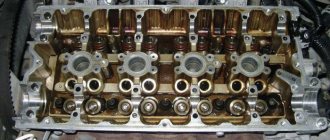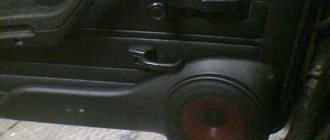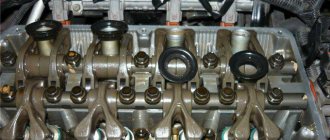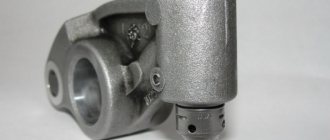Published:
10.06.2016
The hydraulic compensator is an important part of the automotive system. It allows you to eliminate the negative consequences in the valve actuator after exposure to high temperatures. When the machine operates, the power unit heats up, causing the structural elements to increase. This not only creates significant gaps between them, but can also cause car damage, so it is important to know how hydraulic compensators are replaced.
How to get rid of the knocking of hydraulic compensators with your own hands
Increased engine noise may indicate the presence of serious malfunctions, which can lead to complete inoperability of the unit.
The knocking of hydraulic compensators when cold does not belong to this category, but if this part is not adjusted, the engine will consume more fuel, develop less power and the comfort of driving the car will sharply decrease. The wear of the piston group will also increase due to incorrectly selected gaps in the gas distribution system.
This article will tell you in detail how to eliminate the knocking of hydraulic compensators, as well as how to do this work efficiently and with minimal time and financial costs.
Knocking of hydraulic compensators: reasons
To understand how to get rid of the knocking of hydraulic compensators, you need to have a good understanding of the operating principle of these parts. The thermal expansion of the metal as a result of heating was the reason for the invention of this type of mechanism.
In old-style cars, instead of hydraulic compensators, adjusting bolts were installed, with the help of which the thermal gap was manually adjusted. This method of eliminating increased gaps in the gas distribution system required the car owner to spend a significant amount of time and money, because the need for manual adjustment arose every time the car traveled 10 - 15 thousand km.
In modern cars this function is fully automated using small inserts between the rocker arms and the valve stem. The operating principle of this part is quite simple:
- Oil from the lubrication system enters the cylindrical cone of the compensator under pressure when the camshaft cam does not apply pressure. Inside the part there is a plunger pair, with the help of which the filling of the internal cavity with oil is regulated until the moment when the pressure part of the mechanism extends to a distance that completely compensates for the existing gap between the part and the valve stem.
- At the moment when the camshaft rotates to the angle required to start applying pressure to the valve, the oil supply is shut off and, taking into account the fact that oil is a practically incompressible liquid, the compensator maintains the required length and transmits the force from the camshaft to the valve stem without delay.
- After the valve returns to the closed position, the entire cycle of operation of the hydraulic compensator is repeated again.
Click on the picture to enlarge
Considering the fact that the internal volume filled with oil can vary depending on the size of the gap, it is possible to completely avoid delays in valve opening and, as a result, increased noise of the gas distribution mechanism.
Unfortunately, hydraulic compensators, like any car part, can fail. A malfunction of this part will inevitably lead to the formation of a characteristic knocking sound during engine operation. Most often, hydraulic compensator noise is caused by the following reasons:
- Wear.
- Manufacturing defects.
- Internal valve jammed.
- Air in the internal cavity of the part.
- Valve mechanism clogged.
Hydraulic compensators - good or evil
You often hear that they used to drive without unnecessary parts and complications and did not spend as much money on a car as they have to spend today. But only those who are not familiar with the valve adjustment procedure can say this, especially if the car is driven frequently and over long distances. Well, there is no need to talk about the happy owners of cars with a gas installation. Moreover, even after adjusting the valves, the engine did not always run as smoothly and stably as is the case with hydraulic compensators. As for replacement costs, the engine itself, sooner or later, will exhaust its service life, this is not a reason to abandon it.
Change the oil in a timely manner, or better yet, ahead of time, use a really high-quality product and your hydraulic lifters will start knocking very soon. The undoubted benefit of these devices is evidenced by the fact that many old cars that did not have hydraulic compensators from the factory are equipped with them as an upgrade.
There is not the slightest reason to panic if your hydraulic compensator starts knocking, since replacing these parts is not such a difficult undertaking.
The need to use additives
Replacing the VAZ 2112 hydraulic compensators, a video about which is presented in the article, should be done only after the car owner knows what changes occur when using additives. They promise that they can reduce noise and clean channels and holes in hydraulic compensators. Be careful when purchasing generic additives. Read the instructions carefully. What type of engine is the additive intended for, what oil is it used with. Inattention can damage the engine.
After the VAZ 2112 hydraulic compensators (16 valves) have been replaced, a video about which you can watch in the article, you should inquire about the quality of the additives that are designed to change the properties of the oil. That is, improve the quality in order to achieve the effect we need at the moment. There are additives that improve the sliding effect. Rubbing parts with additives have a lower coefficient of adhesion. Due to this assistance, the engine increases power.
Hydraulic compensators on the VAZ 2109 should be used with additives that can increase the coefficient of adhesion. In automatic transmissions, it is necessary that the two wheels of the turbine transmit torque better. The hydraulic compensator must receive oil constantly and in the required quantity. If these conditions are violated, the operation of the hydraulic compensator is disrupted. This means that the gaps in the gas distribution mechanism will also be compromised. Not only knocks appear, but the normal operation of the engine is also disrupted.
The installation of hydraulic compensators on a VAZ 2107, a video about which you can watch in the article, must be accompanied by the use of the correct additives that will eliminate the consequences described above. If they are really high quality, then the desired effect will be achieved. The channels will be cleaned, the knocking will disappear.
But this effect will happen if the additive is original and not a fake. There are a lot of low-quality additives on the market
Buy with caution, it is better to double check. Liqui moly Hydro, for example, is one of the most popular
If you also use oil from this company, you really get the effect. What the manufacturer promised, he delivered.
Now Hado has appeared on the additive market. It can be purchased at an affordable price. This is a product of the Ukrainian chemical industry. According to consumer reviews, there are no particular complaints. Additives really eliminate noise. Whether or not to use these compounds to eliminate noise and flush hydraulic compensators is up to everyone to decide for themselves. The main thing is to first make sure you need it, and then purchase it.
When purchasing, pay special attention to the manufacturer. Counterfeits must not be allowed to enter
A fake can lead to complex and expensive repairs. But the price should not be too low, since in this case you risk purchasing a fake. The acceptable cost is 900 rubles.
One of the options for improving the VAZ 2107 engine is the installation of hydraulic compensators. This part not only reduces noise from the operation of the power unit, but also completely eliminates the need for periodic adjustment of valve clearances. Installation of hydraulic compensators is possible in a garage, for which you will need to prepare the system elements and the necessary tools.
Design of hydraulic compensators on Niva Chevrolet
On all classic VAZ engines, rockers were installed in the gas distribution mechanism, and valve clearances were adjusted using special screws. The engine systems of the 2123 Niva Chevrolet models are equipped with hydraulic shock absorbers, which are similar in shape to adjusting bolts. Clearance holes are eliminated due to displacement elements and the required oil pressure in the engine. The design, complex at first glance, consists of the following parts:
- Hydraulic compensator housing.
- Return spring.
- A plunger pair, which is divided into two parts - upper and lower.
Reasons for the characteristic knocking sound:
- lack of oil pressure in the system;
- the oil channels in the engine are dirty, causing the entire lubrication system to become clogged;
- lack of oil material in the design;
- the area intended for the hydraulic compensator is worn out;
- parts and components of the device designed to automatically adjust the thermal clearances of engine valves have worn out.
Design of hydraulic compensators and types of devices
The design of the hydraulic compensator in its modern form involves two schemes. However, structurally they differ little, and in any case, the entire mechanism is hidden in a non-separable metal case. The only difference is where the device is mounted: in one case these are the sockets of the gas distribution mechanism, in the other - the sockets of the valve rocker arms. The set of parts in both cases is the same: plunger with bushings, valve and plunger spring, ball valve.
At the moment, there are 4 types of compensators - some are gradually becoming a thing of the past, but are still found in power units, while others are confidently becoming more widespread.
Hydraulic support, the principle of which is based on interaction with levers and rocker arms. Nowadays such mechanisms are practically not found, but in previous generations of power units they were used very actively.
Roller hydraulic pusher - it is used quite often.
Hydro support.
A hydraulic pusher (hydraulic compensator) that regulates the clearances between the valves and the camshaft. Widely used on new car models.
Accordingly, the future lies in various modifications of hydraulic pushers, while hydraulic mounts are quickly becoming obsolete among car designers.
Bottom line
In rare cases, hydraulic compensators begin to knock or break completely. Basically, they serve reliably and unpretentiously throughout the entire declared resource of the power unit. They do not require maintenance, their operation is fully automatic. For preventive purposes, it is recommended to remove hydraulic mechanisms after 80-100 thousand kilometers and clean them of carbon deposits that form after using low-quality motor oil. Replacing one compensator will cost 150-500 rubles, it all depends on the design of the engine. If you turn to a specialist, you will have to pay several thousand rubles on top for the work. To increase the service life of the compensator, remove low-quality lubricants from the engine’s diet, giving preference to famous oil manufacturers: Motul, Castrol, Liqui Moly.
Debugg
Since there are several hydraulic compensators in a car, it is worth using acoustic diagnostics to determine the faulty one. An experienced technician knows how to check hydraulic compensators for functionality using acoustic diagnostics, that is, sound.
For an experienced master, such manipulations are not difficult. After identifying the problematic hydraulic compensator, to eliminate the knocking, it is necessary to wash it, return it to its place and restart the engine. If this measure does not help, you will have to replace it. Let's consider step-by-step actions in the case of both procedures.
How to wash the hydraulic compensator?
The mechanism in question must be washed in a room protected from dust and drafts. It won’t be possible to not disassemble the engine at all, but there is also no need to rid it of every screw.
At the preparatory stage, prepare three deep containers the size of the compensator, as well as a flushing liquid, which can be kerosene or good 92-grade gasoline.
Also, before washing, leave the car in the garage for a day to allow as much oil as possible to drain into the pan. Further actions are as follows:
- Disconnect the battery to de-energize the car.
- Get rid of the air filter.
- Remove the bolts to remove the cylinder head cover.
- Remove the hydraulic compensator from its sockets after removing the rocker arm axles.
- Use a synthetic bristle brush to clean the outside of parts.
- Wash the hydraulic compensators in the first container. To do this, immerse each of them in the liquid and press the ball valve through the hole in the plunger using a wire. Be careful not to break the spring. Next, press the plunger itself. As soon as you notice that the movement has become easier, carefully squeeze out the valve ball and drain the fluid from the compensator. Use a syringe to additionally rinse the channels in the body and proceed to a similar rinse in the second container.
- At the final stage, you will be tested; for this you will need a third container with flushing liquid. How to check hydraulic compensators before installing them in place? It is enough to dip them into the third container, draw liquid into the HA and lower the valve, then remove the part with the plunger up. If you press the plunger with your finger, it should not move.
- If there is no movement, return the parts to their place by installing the rocker arms, cylinder head cover and other elements. Remember to tighten the bolts from the middle to the edges.
After the assembly is completed, start the engine and wait a couple of minutes until it idles, at which there should be no knocking after flushing. Cleaning also helps get rid of knocking after the engine warms up and reaches operating temperature.
Repair of hydraulic compensators
Replacing hydraulic compensators or repairing these timing elements yourself is, frankly speaking, very rarely required. This is due to the fact that the design of the mechanisms is thought out to the smallest detail and their actual breakdown is often caused not by the working conditions, but by the carelessness of the machine owner. The latter, of course, is not available to all motorists, which is why not many require hydraulic lifters to be repaired.
In any case, knowledge is power, so information about the symptoms and general principles of repairing hydraulic slack adjusters will be useful. First, let's pay attention to the signs of hydraulic compensator failure. Often they are more than transparent and are represented by the following list:
- the motor began to work unstably;
- movement dynamics were disrupted;
- “knocking” noises appeared in the operation of the internal combustion engine;
- burnt valves;
- fuel consumption has increased.
Naturally, the more symptoms appear, the greater the grounds for thinking about repairing hydraulic compensators yourself. Why do it yourself, and not at a service station? It's simple. There are no particular difficulties in repairing parts, so giving a considerable amount of money to other people is probably pointless.
Returning to the question of how to check hydraulic compensators for correct operation, we will have to state an unpleasant thing for many motorists - without removing the elements from the engine, diagnostics will not be possible. Taking into account this feature of the repair, we will consider replacing and checking the hydraulic mechanisms together. In general, the process of repairing hydraulic compensators looks like this:
- First of all, we completely change the engine oil and oil filter. If after this the knocking or other symptoms of a breakdown do not go away, proceed to the next step. Don’t forget that after changing the oil, the hydraulic compensators need to be pumped. How to bleed hydraulic compensators? No, the system will do everything itself after starting the engine. More precisely, the oil pump will pump new lubricant into each hydraulic mechanism and only after that they will stop knocking, which will allow you to evaluate their new work. Often this takes 5-15 minutes, no more;
- So, apparently, there is no effect? Then we partially disassemble the motor to access the valve mechanism. On many car models, it is enough to remove the cylinder head and dismantle other engine components that interfere with access to the valves;
- After this there are two options:
- The first is to find a faulty hydraulic compensator. The procedure is not complicated and is carried out as follows: we move the rocker arm and pusher rod of each valve as far away from the hydraulic mechanism as possible and try to press the latter with a drift. If the compensator goes down under significant pressure, then it is in good order, otherwise the part should be removed for a better check;
- The second is to remove all hydraulic compensators to check each one. When choosing this option, a standard disassembly of the valve mechanism and the elements of interest to us are carried out, respectively.
- Having carried out the operations described above, all that remains is to replace the faulty timing element and return the car to its original condition. If the mechanisms were disassembled, then it is necessary to check their internal condition and clean them of carbon deposits. If everything is normal with the regulator, then the hydraulic compensator should be installed back into the motor structure and only then checked for functionality. Under other circumstances, the unit must be completely replaced. We will not talk in more detail about how to disassemble the hydraulic compensator, since this procedure is not so complicated and can be done by any motorist. The main thing is to act carefully and slowly.
It is probably pointless to provide more information on how to replace hydraulic compensators. Practice is more important here, so stock up on a basic car repair kit and head to the garage, of course, if you need something like this.
Hydraulic compensators VAZ 2107
Hydraulic compensators are devices that independently adjust the valve clearance. The part is a more advanced product compared to the mechanical type regulator that was used on older cars. On the VAZ 2107 and other “classics” hydraulic compensators (GKK) were not installed. As a result, every 10 thousand km. mileage it was necessary to adjust the thermal clearance of the valves. The adjustment procedure was carried out manually, i.e. it was necessary to dismantle the valve cover and set the gaps using a special feeler gauge.
Description: why hydraulic compensators are needed and how they operate
The mechanical elements that are responsible for adjusting the gap wear out over time. If the gap is not adjusted in a timely manner, engine noise will appear, dynamics will decrease, and gasoline consumption will increase. As a result, with a mileage of 40–50 thousand km. the valves themselves need to be replaced. To put it briefly in terms of mechanical adjustment, this design is far from perfect.
When equipping the engine with hydraulic compensators, you do not need to think about the need to adjust the valves. The hydraulic support itself will set the required gap, which has a positive effect on the life of the power unit, increasing power, and reducing fuel consumption. In addition, the part is characterized by a fairly long service life - about 120-150 thousand km. mileage To fully understand how hydraulic compensators work on the VAZ 2107 and any other car, it is worth considering their operating principle.
Motor oil enters the hydraulic element through a special valve in the form of a ball. The lubricant extends the GKK piston, changing its height. As a result, a position is reached in which the hydraulic part minimizes the valve clearance in the gas distribution mechanism. After this, oil does not flow into the hydraulic compensator, since there is a certain (maximum) pressing moment. When a gap forms between the valve and the hydraulic element, the valve mechanism opens again and pumps oil. As a result, high pressure is always created in the GKK, providing maximum compression.
In addition to the listed advantages, hydrosupport also has disadvantages:
- the need to use high-quality oil;
- repairs are more complex and expensive.
Signs of malfunctioning hydraulic compensators and their causes
Like any other car part, hydraulic compensators fail over time and there are characteristic signs of this:
- the appearance of a knocking sound;
- reduction in power of the power unit.
Clunking noise under the valve cover
The main sign indicating a problem with the hydraulic mount is an extraneous knocking sound (clattering sound) after starting the engine, coming from under the valve cover. Since the noise and the reasons for its appearance may differ, you need to learn to distinguish the nature of the knocks and only then draw the appropriate conclusions.
- Knock in the engine when starting. If the noise disappears a few seconds after starting the power unit, then this effect is not a sign of a problem.
- The appearance of a knocking sound from the hydraulic mounts on a cold and warm engine, while the noise disappears when the speed increases. The probable cause is wear of the check valve ball, which indicates the need to replace the main valve. The problem can also occur when the hydraulic element is dirty. To fix the problem, resort to cleaning.
- The knock is only present when the engine is warm. This type of noise indicates wear of the hydraulic compensator elements. The part must be replaced.
- Knocking noise when the power unit operates at high speeds. The problem can be either too much or too little engine oil. In this case, it must be monitored and brought to normal. The reason may also be related to problems with the oil receiver, which will have to be eliminated.
- Constant presence of knocking. The likely cause is clearance between the camshaft lobe and the rocker. The problem is eliminated by cleaning or replacing worn-out parts.
Pros and cons of hydraulic compensator
It is also worth saying that today several types of hydraulic compensators are known: in the form of a hydraulic pusher or a roller mechanism, or a hydraulic support. The obvious advantages of such a mechanism compared to what was before are much greater than the disadvantages. Thanks to the hydraulic compensator, the engine of a modern car has become more advanced in terms of design. The obvious advantages include the following:
- The compensator does not need to be serviced, it works automatically
- Increases the resource of timing elements
- Creates the maximum possible pressure
- Significantly reduces fuel consumption
- Reduces engine operating noise
Many motorists are familiar firsthand with one of the main drawbacks - when hydraulic compensators knock. This is the main problem of the mechanism, which, as a rule, makes itself felt when the resource of the part is completely exhausted. Other significant disadvantages include:
- The operation of the compensator is possible due to oil pressure, therefore, the use of low-quality lubricants is unacceptable
- If it fails, expensive repairs will be required.
- They tend to clog, which does not have the best effect on the functionality of the engine.
- Complex design causes difficulties during repairs
They can knock not only for the reason that “the time has come,” but also because the oil was poured “anyhow.” It is necessary to use a certified product from a reliable manufacturer, then there will be no premature failure.
Diagnosis of GCC
Listening to knocks and monitoring the dynamics of the VAZ 2107 engine is, of course, a useful habit. But you still have to roll up your sleeves and drive the car into the garage. After all, for an accurate diagnosis, you need to get the device and inspect it personally.
- Remove the valve cover.
- Using a special wrench, rotate the crankshaft so that the cylinder piston is in the compression stroke.
- Try pressing the rocker arm on the intake valve.
If the rocker arm easily gives in to your efforts, the hydraulic compensator requires replacement.
You can also check the functionality of the hydraulic supports using a screwdriver. If you press on a faulty mechanism, it will give play.
Principle of operation
As you know, when a car is running, its mechanisms heat up, causing them to expand. To prevent hardware failure, even at the design stage, the manufacturer provides for the installation of special gaps, which, in accordance with the increase in temperature, use up excess space.
To understand what hydraulic lifters are needed for, it is important to understand their operating process. The essence of their action is to control the gap between the gas distribution mechanism and the valve. This works by using a special piston that extends and accommodates the resulting gap.
Scheme of operation of hydraulic compensators
During long-term operation, many parts wear out, and their geometry changes for the worse. Since the gap between the elements also becomes different, this negatively affects the entire motor. To solve this problem, it is necessary to compensate for the gaps - this is the principle of operation of hydraulic compensators. Thus, there is no need to adjust the valves during service, because there is constant contact between the cam and the pusher without clearance.
Alternative.
My neighbor, who has owned a Niva-Chevrolet for more than 10 years, advised us to replace them completely with simple adjusting bolts from our domestic “classics”. He himself had already changed the hydraulic lifters 2 times until he was advised to do so in one of the services. Since then he hasn't had any problems.
Having gone to the service center, I consulted with specialists. They confirmed to me that on Niva they make such a replacement quite often and then do not return to them with problems.
It is not a problem to purchase adjusting bolts. In a store nearby they cost 800 rubles for 8 pieces. The problem was finding plates for them and springs for the rocker.
But this matter was resolved quite simply by disassembly, and cost 300 rubles for everything including bolts!
The service work, including adjusting the bolts and replacing the valve stem seals, cost me 1,000 rubles. Total issue price is 1300 rubles. + hour of time.
You can do it yourself, but the prospect of removing the camshaft and then installing it correctly, to be honest, did not appeal to me.
Installation of hydraulic compensators on a VAZ 21214
To work you will need:
— Clean motor oil
— Tweezers (can be replaced with a slotted screwdriver)
Before installing the HA, they must be disassembled and thoroughly washed in gasoline. Dry and put back together. After that:
- We check the hydraulic supports. To check, you need to press your thumb on the assembled hydraulic support; it should squeeze and move apart freely (without jamming)
- The next step is to install the oil supply ramp and screw in the dry hydraulic mounts by hand
- Using a torque wrench, tighten the hydraulic mounts (22 N per m). Again we check that when pressed it is pressed all the way, and then returns to its original position. If it sticks:
a) swap the hydraulic support with the neighboring one
b) reduce the moment to 18 n per m
c) replace with a new one
!All hydraulic clamps must be tightened to the same torque
4. Next, you need to fill each hydraulic mount with oil. To do this: take out the plunger and put it in a clean place, use tweezers to take out the piston with the ball and also put it aside; We fill the engine oil into a syringe and fill it into the hydraulic support housing to the brim, after which we lubricate the piston and insert the piston into the housing, pressing the valve ball with an awl. Fill the plunger with oil and insert it into the body.
All steps have been completed and the hydraulic mounts have been installed, then you need to get the engine into working condition. After that you can safely start!
Source
Violation of functionality
During normal operation of the device, the driver does not feel any extraneous sounds. If they occur, it may be the cause of part failure or poor engine performance. If you don’t know what hydraulic compensators are in an engine, you should immediately seek advice from a specialist.
There are main causes of failure, which are determined by the following factors:
- You need to check the oil level. If its level in the crankcase is too high or low, this means that it will be compressed inside the hydraulic compensator, causing problems in the operation of the engine.
- Natural wear and tear. Elements of the device may become worn.
- During operation, parts may become contaminated, which is why the hydraulic compensators need to be replaced.
The easiest way to determine problems with parts is to listen to the engine. Sometimes drivers confuse this characteristic sound with broken valves. To avoid mistakes, it is better to use a phonendoscope, which will give the correct result when comparing sounds.
Dismantling and installation process
The faulty element must be removed. If you remove the hydraulic compensators from their installation site, you can determine the degree of wear. If the element is easily compressed under the force of your fingers, it is worth replacing the part. When you cannot disassemble the device, you should contact a car service center.
If it is necessary to install hydraulic compensators, you will need to assemble a set of tools and a set of components. First of all, you will need to remove part of the filter on the housing. After this, the over-valve casing and accelerator rod are removed. It will be necessary to disassemble the control washer from the camshaft. It is important to follow the marked marks so that they match. Next you need to unscrew the fastening from the sprocket. After this, the camshaft mount is dismantled, the rockers, cams and regulator bushings are removed.
Next, a saw is used to level the tide at the second valve in order to align it with the rest of the sockets. It is important to degrease the surface with kerosene and sharpen the elements with a fine sharpener.
Remember the positions of the bushings
In subsequent work, it is necessary to press the washers of the support cylinder, using a special mandrel for this. After this, the seal rings are pressed into the distribution plate. Sometimes it is not possible to replace hydraulic compensators the first time if the seals and seats do not match, so you should take care of this in advance before purchasing kits. Next, the plungers are checked to see if they have free movement, after which the spring elements are installed.
After this, the plungers are inserted back and their stroke is adjusted. The camshaft is mounted in the same way, which is installed according to the instructions. Setting the stroke of the plungers is not always easy. To do this, you can make a substrate from washers of different thicknesses in order to align them with a mandrel.
Next you will need to drill out a line for oil flow. It is premature to remove the camshaft and make a thread. In order for the tube to always be in a vertical position, you will need to cut the thread only to a certain length, creating a slight bend to the required amount until both holes of the cross coincide. Then you can reassemble in the order that was required to disassemble the hydraulic compensator.
Final works
The lubrication system and its pipelines are installed. After this, oil is poured and closed with a sleeve. You need to install a valve in the form of a ball and a plunger, not forgetting to check the tightness. This can be easily checked by placing a ball in the plunger and blowing it out. If the air “holds”, the result is satisfactory, but if not, the ball will need to be replaced. It is also important that the plunger creates a noticeable pressure on the sleeve when pressed.
Replacing rocker arms on a VAZ 2107
Rockers (rocker arms) are one of the elements of the valve timing mechanism of the VAZ 2107 engine. The purpose of the part is to transmit energy from the camshaft cam to the valve stem. Since the rocker is constantly exposed to mechanical and thermal stress, it wears out over time.
Rocker arms are designed to transfer energy from the camshaft lobe to the valve stem
Determining the suitability of rocker arms
If during operation of the “Seven” there is a decrease in engine power or a characteristic knocking sound is heard in the cylinder head, then the likely cause is a broken rocker arm. During repair work, it is necessary to clean the rockers from dirt and carbon deposits and check them for wear and damage. If any defects in parts are found, they are replaced with new ones. If the rocker arms are in normal condition, install the products on the cylinder head.f
If the rocker arm is heavily worn or there is visible damage, the part needs to be replaced
Is it possible to level the rocker arm?
When adjusting valves or repairing the cylinder head, you may notice that the rocker arms are slightly at odds with respect to the camshaft, i.e., the distance between the rocker plane and the camshaft journal is not the same. To eliminate this nuance, some owners of “classics” align or change the springs that press the rocker arms, or replace the rocker itself, but the problem may still remain. In fact, on all classic Zhiguli models, including the VAZ 2107, misalignment is not as bad as incorrect valve clearance
Therefore, it is the gap that deserves attention. The main thing is that the parameter is adjusted properly and is 0.15 mm when cold
When the rocker arm is skewed, some motorists change the part itself, the springs, and sometimes the camshaft, but they do not achieve the desired effect
How to replace a rocker arm
If there is a need to replace the rocker arms on the “seven”, for example, 1 part in case of its breakdown, then it is not necessary to dismantle the camshaft. To do this, it will be enough to pry the spring with a screwdriver, remove it, and then remove the rocker itself. The new part is installed in the reverse order. If all the rocker arms are being replaced, then it is wiser to dismantle the camshaft.
Video: replacing the rocker on a “classic” without removing the camshaft
Equipping the VAZ 2107 engine with hydraulic compensators improves its operation and characteristics. Installing the mechanism will not take much time and effort, but will require material costs. Therefore, whether there is a need for such an engine modernization or not, each motorist decides for himself.
What to do if hydraulic lifters are knocking
What does a hydraulic compensator look like?
Since we have figured out why expansion joints knock, let's talk about what should a car owner do when he hears such a knock?
In general, there are no special alternatives here. You can, of course, wash the compensator to clear the clogged channels, but this is a temporary measure, since if there is a knock, it means there is a backlash. One way or another, the hydraulic compensators will need to be changed. And the plural is not a typo here. As a rule, if it starts knocking, at least one hydraulic compensator is replaced with all such components. They run on the same oil, and if one wears out, the others will follow very soon. Therefore, all compensators are replaced without exception.
Reasons for failure of VAZ 2112 hydraulic compensators
- Using inappropriate or poor quality oil
- Oil filter malfunction
- Failure to comply with oil change schedules
- Increasing the landing gap in the plunger pair
- Worn high pressure chamber check valve
- Incorrect operation of the engine lubrication system
- “Airiness” or partial filling of the hydraulic compensator with oil
- Microparticles of worn parts entering the hydraulic compensator in the oil
In this article we will tell you how to correctly replace hydraulic compensators on a VAZ 2112. What you need to consider when purchasing this part, and what alternative options are available when replacing this device.
Causes of knocking hydraulic compensators
The main reasons for knocking hydraulic valves include two malfunctions:
- mechanical parts of the hydraulic compensator
- engine supply oil to hydraulic compensator
Mechanical faults include:
- Wear and wear of the plunger spring. Most often this is natural wear and occurs due to the fact that the camshaft lobes leave wear on the surface.
- Clogged hydraulic compensator. Namely, a clogged valve that is responsible for the oil supply. As a result of this malfunction, the hydraulic compensator begins to stick.
- Airing. Occurs when there is insufficient oil supply to the mechanism.
- Carbon deposits and contamination of the main elements of the hydraulic compensator. Occurs when using low-quality oil or additives.
Why are hydraulic “adjusters” needed?
As the engine gradually reaches operating temperature, its other components also heat up. The associated expansion of parts causes a decrease in a variety of gaps in the power unit. And adjusting the gaps in the gas distribution mechanism is a very important operation, since the stability of the engine largely depends on it. It is clear that manual adjustment is a tedious and ineffective task; special mechanisms cope with it much more successfully. Moreover, during active vehicle operation, the valves are constantly under both mechanical and thermal load. And we must not forget that all timing components heat up unevenly, which, combined with natural abrasion, leads to increased wear of the valve mechanism.
The operating principle of hydraulic valve compensators is based on ensuring optimal thermal clearance. But it should be different, since the intake valves, compared to the exhaust valves in contact with hot gases, heat up an order of magnitude less. In addition, “regulators” are able to take into account the wear of the valve mechanism, although this does not solve the problem of increased fuel consumption and a decrease in engine power.
Returning to the issue of manually adjusting the timing belt, one cannot help but notice that such an adjustment should be carried out after 15 thousand km. However, it is highly not recommended to carry out such a procedure without very specific skills, since it is necessary to take into account a wide variety of temperature fluctuations. This is the same as in the case of the average temperature in the ward, which does not provide objective data on the condition of the patients. And a completely different matter are hydraulic compensators that regulate the gap automatically, taking into account current parameters.
Operating principle of hydraulic compensator
A ball-shaped valve supplies engine oil to the hydraulic element cavity. Under the influence of lubricant, the piston of the device extends, which leads to an increase in the height of the hydraulic valve. This leads to a reduction in the valve clearance in the gas distribution mechanism to a minimum level.
The oil stops flowing when it reaches the maximum compression level. When production occurs, the valve again releases the required amount of oil. Thanks to this, pressure is constantly maintained in the GKK, which reduces the valve clearance.
If you decide to install a compensator, be prepared to use only high-quality oil.
Basic faults
Hydraulic compensators, like any car part, tend to wear out and break. They are constantly under load. But they work for a long time: from 120 to 150 thousand mileage. Sometimes they fail ahead of time.
Two circumstances indicate a malfunction:
- a characteristic knocking sound appears, reminiscent of a clattering sound;
- motor power decreases.
Engine knock
The main sign of wear of a spare part is the appearance of a clattering sound. Since extraneous knocking noises can occur on the VAZ 2107 for various reasons, you need to check what is its source. To do this, you will have to open the hood and start the engine.
A characteristic clattering sound comes from under the valve covers and does not disappear while the engine is running. At the same time, the sound may have interesting features.
- The knocking noise appears on both a warm and cold engine. If you increase the speed, it may stop. This indicates possible valve ball wear. The hydraulic compensator will have to be completely replaced. But before doing this, make sure that the device is not dirty. A good cleaning may easily fix the problem.
- The engine starts knocking only after warming up. This indicates that the elements of the part have worn out. It's time to buy a new one.
- The characteristic clattering sound appears only at elevated speeds. Most likely there is too much or too little oil coming in. You need to check its level. And if necessary, repair the oil receiver.
- The knocking is constantly present and does not subside under any conditions. This usually occurs when there is a gap between the rocker and the camshaft lobe. Try cleaning the hydraulic compensator or replacing it with a new one.
Reduced power of the power unit
If the hydraulic compensator malfunctions, this inevitably leads to a decrease in engine power. You will feel that the dynamic characteristics of the VAZ 2107 have decreased. And this is not surprising!
Indeed, as a result of an incorrectly set valve clearance, the wrong amount of fuel enters the engine. As a result, the fuel mixture is formed in incorrect proportions, which reduces the power of the power unit.
What it is
Hydraulic compensators are parts for tuning a car engine. The device automatically adjusts the valve clearance.
The GKK was never installed by the factory on the old sevens. Some cars of that time had mechanical type regulators. But the efficiency of their work left much to be desired.
Owners of the VAZ 2107 must manually adjust the valve clearance every ten thousand kilometers. To do this, you have to dismantle the cover and use a feeler gauge to set the gaps.
Built-in mechanical elements are subject to wear. An incorrectly adjusted gap leads to increased engine noise. As a result, the car's dynamics decrease and fuel consumption increases. After 50 thousand mileage it is necessary to install new valves.
Hydraulic compensators on the VAZ 2107 are free of these disadvantages. The part lasts a long time: it works properly for up to 150 thousand kilometers. The gap is set automatically and is constantly maintained at the desired level.
The engine responds positively to such care, which is reflected in an increase in engine life, its power and in a decrease in gasoline consumption.
Installation of hydraulic compensators on a VAZ 2107
To install the elements on the “seven” yourself, you need to have the following tools and accessories on hand:
- Torque wrench.
- A set of wrenches (socket wrenches, socket heads, open-end wrenches).
- Drills and electric drill.
- Copper and steel wire.
- New gasket for the timing cover.
- Angle grinder or some files.
- Rags.
- Fine abrasive grinding disc.
- Set of hydraulic compensators.
- Frame for block head washers.
- Mechanism for replacing plungers.
Even before checking the hydraulic compensators, you need to prepare a special tool - without it it is quite difficult to carry out all the work.
List of elements that will be needed for work:
- one camshaft stud;
- camshaft assembly VAZ 21214;
- 8 hydraulic compensators from the same model;
- oil ramp from VAZ 21214;
- 8 rockers.
If the old rockers are in good condition, there is no need to replace them. Tools and materials you will need:
- torque wrench;
- standard set of wrenches;
- set of heads;
- flat screwdriver;
- wire;
- timing cover gasket;
- rags.
We provide access to the valve cover by dismantling the air filter housing, carburetor and distributor. The last two devices are removed only for convenience.
To access the timing mechanism, dismantle the filter with housing, carburetor and distributor, and then remove the valve cover
Turning the crankshaft with a 38mm wrench, set it to a position where the mark on the camshaft coincides with the casting on the bearing housing.
By turning the crankshaft, we establish a position in which the mark on the camshaft gear will coincide with the protrusion on the bearing housing
Using a screwdriver, bend the stopper of the camshaft gear bolt and unscrew the fastener with a 17mm wrench. We fix the chain on the sprocket with wire.
To avoid the chain falling inside the engine, we tie it with a wire to the camshaft gear
Using a 13mm head, unscrew the bearing housing and completely remove the camshaft.
When removing springs and rockers, the latter must be numbered in order to be installed in the same order
Using a 21mm socket, unscrew the bushings of the adjusting bolts.
We unscrew the adjusting bolts together with the bushings using a 21mm head
- Before installing the oil ramp, we blow it with air using a compressor.
- We install hydraulic compensators through the ramp, having previously removed the stoppers. First, tighten the tensioner slightly, and then to a torque of 2–2.5 kg/m.
Before installing hydraulic compensators, remove the locking elements from them
We install the new camshaft and place the oil rail ring on stud No. 1.
When installing the camshaft on the cylinder head, place the oil rail ring on stud No. 1
We tighten in a certain sequence.
To prevent the oil line from resting on the valve cover, it should be given a certain shape
We reassemble all dismantled elements.
Assembly nuances
After replacing 16 hydraulic compensators, everything must be restored to its original form. The most important operations in order:
- We clean and degrease the camshafts and seats of the bed and valve cover, both on the parts and on the engine.
- We change the seals, plugs and put both shafts in place. The inlet has a special belt, which is not present on the outlet. This is its distinctive feature.
- Apply Gasket sealant to the mounting location of the camshaft bed and mount it (no gasket required).
- We treat the fit for the valve cover with sealant and mount it (no gasket required).
- We install injectors, condenser tubes, mount the manifold, generator, its belt, pulleys and timing belt.
- We restore the operation of the throttle valve, filter and connect all the wires.
